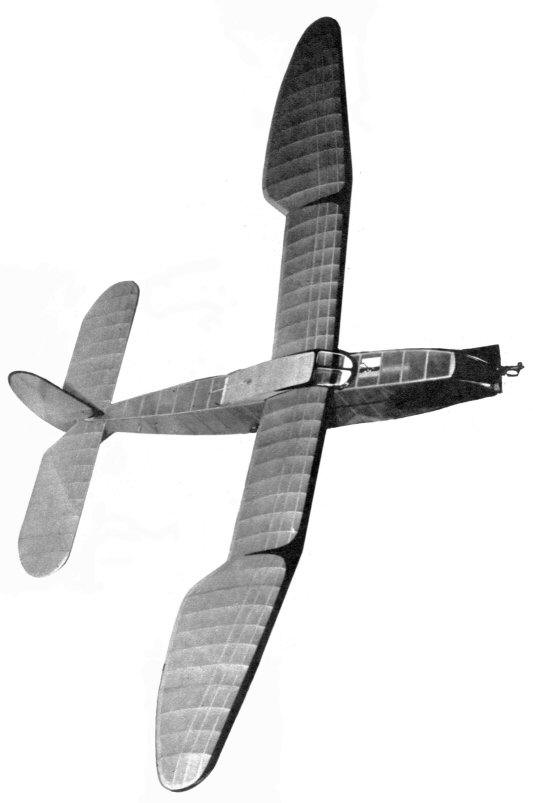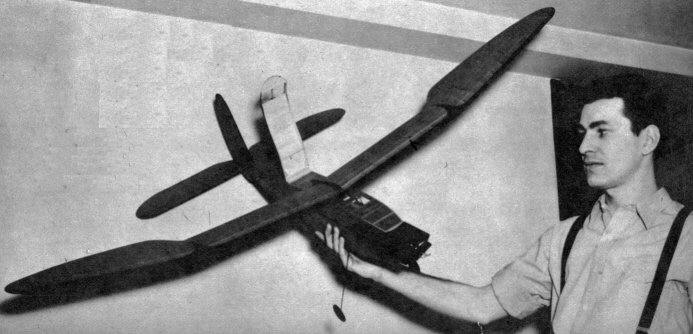|
Lanzo's Record Holder BY CHESTER LANZO Easy, economical to build, this Class E rubber job
THIS plane is a replica of the model with which I set a world record for Class E rubber-powered models during June, 1941. Slight modifications have been made in design to improve flight characteristics. A dethermalizer is used on this model to bring the ship down when caught in a thermal. It consists of a hinged cabin that assumes a vertical position when the air timer inclosed in the body releases it. The cabin at this angle produces a tremendous amount of drag. The ship loses forward speed, causing its descent. This has proven to be better than the rubber-tab method of dethermalizing, which I used on my record stick job in 1940. I originated this idea to prevent the loss of models caught in powerful thermals. The rudder-tab method of dethermalizing causes the ship to come down in a tight vertical spiral dive at a very rapid rate of speed. This inherent characteristic usually removes approximately one half of the forward portion of the model upon coming in contact with the ground. With the hinged cabin, the model comes down in a horizontal position, and is in no way injured. This plane reaches Class B (gas job) proportions and will give any type of model plenty of competition. So be sure to set the timer before trying any hand glides, or you might be off for a long run. This model has, on previous occasions, flown for 63 and 30 minutes. Here is how the dethermalizer functions. Just before taking a flight with the rubber motor fully wound, decide upon the length of time the model will remain in sight, pull the timer up to the proper marking on the body. The timer extension arm will then hold the cabin down to the body, when the timer arm disengages the cabin wire catch. The rubber band situated at the rear of the cabin, will pull the cabin to a vertical position and keep it there. Your model will then start to descend. CONSTRUCTION Pin down the fuselage sides to the drawing and add the uprights and diagonals. The longerons should be extremely hard balsa, as they take all the strain of the thirty-six strands of rubber. After removing the sides from the drawing, cement in the cross braces and then join the rubber end. The nose block is formed from hard balsa by the generous use of very coarse sandpaper. Add the 1/32" plates to the front and rear of the nose piece, being very sure you allow two degrees downthrust to prevent the ship from stalling under power. Cement the wire landing between two pieces of 1/32" plywood and fill in the hollow portion with 1/16" sheet balsa. Next place the landing gear in between the proper body uprights. Add small balsa triangles where needed. Fill in the front section of the body with light 1/8" sheet balsa. This increases the strength greatly. The rear-hook portion is filled in with 1/8" sheet and the dural plates are added. these are used to anchor the 3/18" dowel for securing the rubber motor. The prop is a double-bladed folder and has proved to be very efficient. Carve from the block shown and cut in two. A center piece of balsa is then added. Take care when forming the hinges over the .040 wire not to get them too tight. The hinge must be rolled over the .040 wire to a smooth fit and the ends formed at the proper angle to assure a snug fit for the blade against the fuselage. The rudder outline is first cut from 1/8 " sheet balsa and the leading edge is added. Then place in the ribs, and after the assembly is dry, remove it and add the spars. The rudder and stabilizer are cemented in place after covering. Construction of the elevator is a simple matter, but be careful to eliminate any warps, as a warped elevator will produce a very erratic flight. Wing construction is of the multispar type. The center section is built first, then the tips. are added. Cement all the top spars in place first, and after the wing is removed from the board the bottom spars may be added. The wing is of a glider type outline and is very efficient. The multispar type of wing construction produces a very rigid wing. This characteristic is apparent when the model is under full power, as it tends to eliminate torque dives. The final part to be constructed is the cabin cover. This serves to streamline the wing-mount portion of the plane and also acts as a dethermalizer, as already mentioned. Begin by cutting the two sides from 1/8" sheet balsa, then cut the proper amount of crosspieces and glue them in place, making sure the cabin is the same width as the body. The window braces and the 1/16" sheet semicircular former are added next. The top portion of the cabin is then covered with 1/32" sheet balsa. Windows are covered with sheet celluloid. Before the fuselage has been covered, the timer is glued in place with small blocks of balsa. The timer is an Austin Air Timer, with part of the body and insulation removed to provide a better fit. Two holes are drilled in the timer knob and the timer extension arm is wired and soldered firmly in place. Set the timer to run approximately a half-hour from full-out position. The wire catch is then added to the cabin; this serves to hold the cabin in position against the pull of the rubber band at the back. Now place the rest of the wire parts in their proper positions, and the cabin is finally attached to the body by a small strip of silk which acts as a hinge. The body and wings are covered with gas Silkspan, the rudder and elevator with Japanese tissue. The power used in the ship is thirty-six strands of 3/16" flat brown rubber fifty inches long, well soaked in a good grade of lubricant. The one-hundred-inch length is then wound about a hundred and fifty turns; place the two ends together and the rubber will entwine to form a compact motor equal to the length of the body. Scanned From August 1942 |

